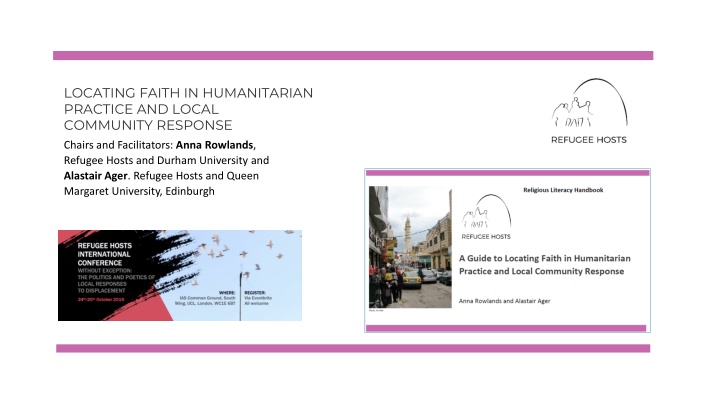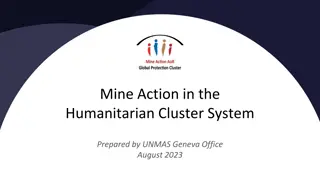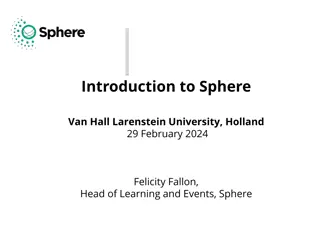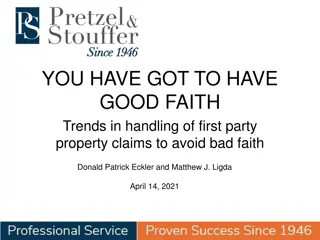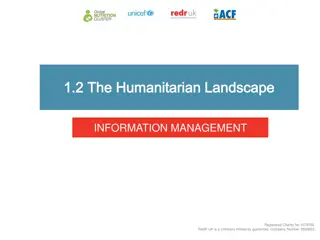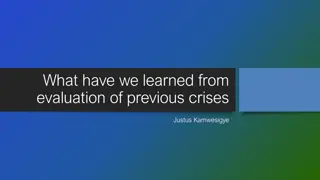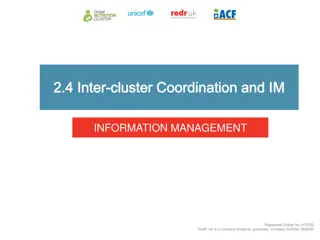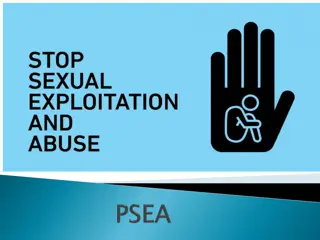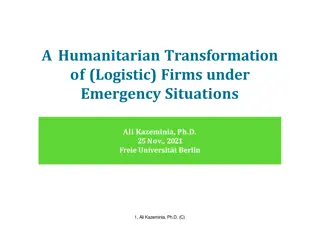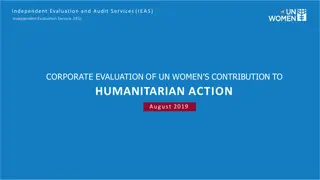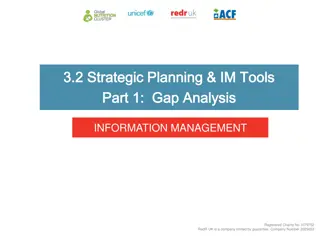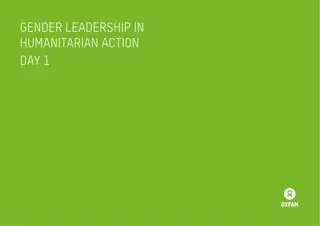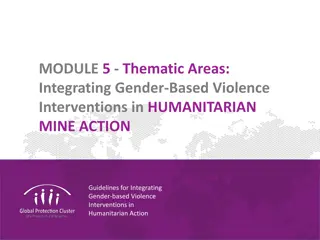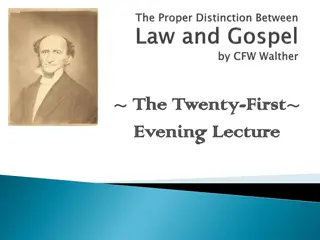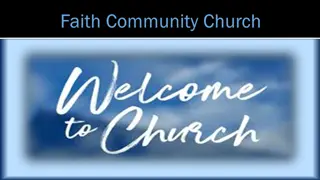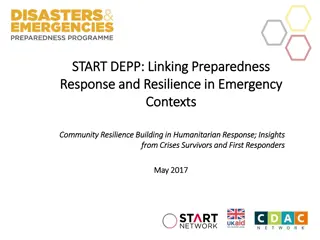Faith in Humanitarian Practice and Local Community Response
Delve into the intersection of faith, humanitarian practice, and local community response with expert facilitators from Refugee Hosts and Durham University, Anna Rowlands and Alastair Ager. Gain valuable insights and perspectives on the role of faith in shaping humanitarian efforts and community responses to crises.
Download Presentation

Please find below an Image/Link to download the presentation.
The content on the website is provided AS IS for your information and personal use only. It may not be sold, licensed, or shared on other websites without obtaining consent from the author.If you encounter any issues during the download, it is possible that the publisher has removed the file from their server.
You are allowed to download the files provided on this website for personal or commercial use, subject to the condition that they are used lawfully. All files are the property of their respective owners.
The content on the website is provided AS IS for your information and personal use only. It may not be sold, licensed, or shared on other websites without obtaining consent from the author.
E N D
Presentation Transcript
LOCATING FAITH IN HUMANITARIAN PRACTICE AND LOCAL COMMUNITY RESPONSE Chairs and Facilitators: Anna Rowlands, Refugee Hosts and Durham University and Alastair Ager. Refugee Hosts and Queen Margaret University, Edinburgh
A GUIDE TO LOCATING FAITH IN HUMANITARIAN PRACTICE AND LOCAL COMMUNITY RESPONSE The following claims are foundational to the Handbook: The ubiquity of belief Religion as contextual and non-exceptional The relevance of time as well as space. The importance of humanitarian action being informed by wider contextual analysis
A GUIDE TO LOCATING FAITH IN HUMANITARIAN PRACTICE AND LOCAL COMMUNITY RESPONSE We view religion, variously, as: An everyday part of identities and systems of meaning for displaced persons and for host communities A causal factor in conflicts and displacement A system of formal and informal humanitarian care and response A system of cultural meaning making, with texts, traditions and practices which shape response to trauma and provide sources for interpretation, resistance and healing, and which shape views of the meaning of time, space and place. We view the strengths of LFAs as humanitarian actors as rooted in: Longevity of presence in communities, including a commitment to future presence Established relationships of trust that LFAs have in localities Benefits of scale: LFA often have capacities for deep, slow accompaniment work that larger organisations lack as well as quick response to immediate material need. The specific capacities and expertise that faith based groups have developed over time and are able to offer to communities, in our interviews FBOs and LFAs felt that their expertise related to relationship building, education and psychosocial care especially and the capacity to build common projects between refugees and local hosts over time. With opportunities come challenges: LFAs can exclude as well as embrace; LFAs have their peripheries and margins too. Informal leadership can be as important as formal and this can be harder to identify The time and relationship building capacities of smaller scale LFAs can act as a limitation when the scale of need is so high; there is often understandable resistance to scaling up LFAs operations The primary function of a LFA is not typically humanitarian, although usually includes some facet of the humanitarian. It is often difficult for LFA to meet various standards and protocols that are set by actors outside of the context. This limits opportunity to bid for funds and to manage monitoring and evaluation. The values framework that comes with working with large secular INGOs can be a barrier to collaboration with LFAs. This can be about perceptions and misperceptions on both sides. Mutual literacy in worldviews and core values can be low.
A GUIDE TO LOCATING FAITH IN HUMANITARIAN PRACTICE AND LOCAL COMMUNITY RESPONSE ___________ _____________ Global Enforces secular framing on humanitarian strategy and engagement Governmental and Political Context ____________ Shapes public and private space for religious expression, engagement & narrative Humanitarian Regime ___________ ___________ Religious belief, self- understanding & institutional capacity drives forms of engagement ____________ Religious Civil Society ___________ Secular principles and institutional capacity drives forms of engagement Secular Groups in Civil Society ____________ ________ Religious belief and affiliation shapes provision of welcome and solidarity Hosts ________ ________ Religious belief and affiliation shapes experience of exile and loss and narratives of agency and resilience Refugees ________
A GUIDE TO LOCATING FAITH IN HUMANITARIAN PRACTICE AND LOCAL COMMUNITY RESPONSE ___________ _____________ Humanitarianism Global and the Enforces secular framing on humanitarian strategy and engagement Governmental and Political Context ____________ Shapes public and private space for religious expression, engagement & narrative marginalisation Humanitarian Regime ___________ privatization instrumentalisation ___________ Religious belief, self- understanding & institutional capacity drives forms of engagement of religion ____________ Religious Civil Society ___________ religion is an active Secular principles and institutional capacity drives forms of engagement Documenting Secular Groups in Civil Society ____________ ________ and effective source of coping in Religious belief and affiliation shapes provision of welcome and solidarity Hosts ________ ________ many Religious belief and affiliation shapes experience of exile and loss and narratives of agency and resilience humanitarian Refugees ________ contexts
A GUIDE TO LOCATING FAITH IN HUMANITARIAN PRACTICE AND LOCAL COMMUNITY RESPONSE ___________ _____________ Global Enforces secular framing on humanitarian strategy and engagement Governmental and Political Context ____________ Shapes public and private space for religious expression, engagement & narrative Humanitarian Regime ___________ ___________ Religious belief, self- understanding & institutional capacity drives forms of engagement ____________ Religious Civil Society ___________ Secular principles and institutional capacity drives forms of engagement Secular Groups in Civil Society ____________ ________ Religious belief and affiliation shapes provision of welcome and solidarity Hosts ________ ________ Religious belief and affiliation shapes experience of exile and loss and narratives of agency and resilience Refugees ________
LOCATING FAITH IN HUMANITARIAN PRACTICE AND LOCAL COMMUNITY RESPONSE Refugee Narratives We keep to ourselves now. We are much less alive than we used to be. I have to say I pray to God that this country is protected I pray at the community's mosque down the street. It's a spiritual space. It emphasizes a number of important values such as brotherhood, love, and equality. We all kneel to the same God, We are equal in front of him. Rich, poor, Jordanian, Syrian, Indian and in front God we all belong to our Islam. We all have an identity and we are all the same. The mosque has brought me closer to the people in the neighbourhood. We were encouraged to help the refugees coming to Daraa because our humanity prompted us to do so. There is a religious saying Khairkom le ahleh and another Al muslim kal jasad al wahed meaning that all Arabs and Muslims are one and therefore we need to help one another and stand up for each other at times of necessity. [Field Notes Jordan, 2018]
LOCATING FAITH IN HUMANITARIAN PRACTICE AND LOCAL COMMUNITY RESPONSE Refugee Narratives Most of the time I said God is not with us, because all of this has happened to us Sometimes, I say mylord I didn t do anything wrongwhy you are punishing me? From all sides, like: I lost my family, my husband is not good with me and I have a sick daughter .(I think about the anger with Allah) if I am sad. So, when problems happen...I say my lord why are you doing this to me?...I still pray and fast, thank God for that I can t (live) without praying. If I don t pray, I feel like I lost something. [Kathleen Rutledge, Field notes, Northern Iraq]
A GUIDE TO LOCATING FAITH IN HUMANITARIAN PRACTICE AND LOCAL COMMUNITY RESPONSE ___________ _____________ Global Enforces secular framing on humanitarian strategy and engagement Governmental and Political Context ____________ Shapes public and private space for religious expression, engagement & narrative Humanitarian Regime ___________ ___________ Religious belief, self- understanding & institutional capacity drives forms of engagement ____________ Religious Civil Society ___________ Secular principles and institutional capacity drives forms of engagement Secular Groups in Civil Society ____________ ________ Religious belief and affiliation shapes provision of welcome and solidarity Hosts ________ ________ Religious belief and affiliation shapes experience of exile and loss and narratives of agency and resilience Refugees ________
LOCATING FAITH IN HUMANITARIAN PRACTICE AND LOCAL COMMUNITY RESPONSE Hosting Narratives Reference was commonly made to the hadith in the Qu ran that talks of the Prophet being hosted in the town of Medina when seeking refuge. One young woman in Jerash reflected on how her school teacher had addressed discrimination and conflicts in the initial period of migration: She reminded us when the Prophet - peace be upon him - emigrated to Al Madinah and how the people of Al-Madinah welcomed them and shared everything with them. After that, we felt ashamed that we treated them in this way. Christian interviewees also drew on sacred scripture to explain the moral basis for engaging with refugees. A church leader in Irbid engaged in supporting food distributions to Syrian refugees reported: We are explicitly instructed in the Bible Do not forget to do good and to share with others [Field Notes Jordan, 2014 and 2018]
LOCATING FAITH IN HUMANITARIAN PRACTICE AND LOCAL COMMUNITY RESPONSE Hosting Narratives Religious interpretation was not only used to underpin perceived obligation for hosting but also as a basis to consider its limits. These varied widely: There is a hadith the believers in their mutual kindness, compassion and sympathy are as one body. When one of the limbs suffers, the whole body responds to it with wakefulness and fever . It is important to note that the Prophet said believers not just Muslims. Anyone who believes should receive kindness, compassion and sympathy. Even if he is Buddhist! Religion has always instructed us to host those in need especially if we have language and religion in common . It s important to note that the people of Mecca didn t overstay their welcome. They were hosted temporarily until they were able to get their lives in order and become independent .
A GUIDE TO LOCATING FAITH IN HUMANITARIAN PRACTICE AND LOCAL COMMUNITY RESPONSE ___________ _____________ Global Enforces secular framing on humanitarian strategy and engagement Governmental and Political Context ____________ Shapes public and private space for religious expression, engagement & narrative Humanitarian Regime ___________ ___________ Religious belief, self- understanding & institutional capacity drives forms of engagement ____________ Religious Civil Society ___________ Secular principles and institutional capacity drives forms of engagement Secular Groups in Civil Society ____________ ________ Religious belief and affiliation shapes provision of welcome and solidarity Hosts ________ ________ Religious belief and affiliation shapes experience of exile and loss and narratives of agency and resilience Refugees ________
A GUIDE TO LOCATING FAITH IN HUMANITARIAN PRACTICE AND LOCAL COMMUNITY RESPONSE ___________ _____________ Global Enforces secular framing on humanitarian strategy and engagement Governmental and Political Context ____________ Shapes public and private space for religious expression, engagement & narrative Humanitarian Regime ___________ ___________ Religious belief, self- understanding & institutional capacity drives forms of engagement ____________ Religious Civil Society ___________ Secular principles and institutional capacity drives forms of engagement Secular Groups in Civil Society ____________ ________ Religious belief and affiliation shapes provision of welcome and solidarity Hosts ________ ________ Religious belief and affiliation shapes experience of exile and loss and narratives of agency and resilience Refugees ________
A GUIDE TO LOCATING FAITH IN HUMANITARIAN PRACTICE AND LOCAL COMMUNITY RESPONSE ___________ _____________ Global Enforces secular framing on humanitarian strategy and engagement Governmental and Political Context ____________ Shapes public and private space for religious expression, engagement & narrative Humanitarian Regime ___________ ___________ Religious belief, self- understanding & institutional capacity drives forms of engagement ____________ Religious Civil Society ___________ Secular principles and institutional capacity drives forms of engagement Secular Groups in Civil Society ____________ ________ Religious belief and affiliation shapes provision of welcome and solidarity Hosts ________ ________ Religious belief and affiliation shapes experience of exile and loss and narratives of agency and resilience Refugees ________
A GUIDE TO LOCATING FAITH IN HUMANITARIAN PRACTICE AND LOCAL COMMUNITY RESPONSE ___________ _____________ Global Enforces secular framing on humanitarian strategy and engagement Governmental and Political Context ____________ Shapes public and private space for religious expression, engagement & narrative Humanitarian Regime ___________ ___________ Religious belief, self- understanding & institutional capacity drives forms of engagement ____________ Religious Civil Society ___________ Secular principles and institutional capacity drives forms of engagement Secular Groups in Civil Society ____________ ________ Religious belief and affiliation shapes provision of welcome and solidarity Hosts ________ ________ Religious belief and affiliation shapes experience of exile and loss and narratives of agency and resilience Refugees ________
A GUIDE TO LOCATING FAITH IN HUMANITARIAN PRACTICE AND LOCAL COMMUNITY RESPONSE ___________ _____________ Global Enforces secular framing on humanitarian strategy and engagement Governmental and Political Context ____________ Shapes public and private space for religious expression, engagement & narrative Humanitarian Regime ___________ ___________ Religious belief, self- understanding & institutional capacity drives forms of engagement ____________ Religious Civil Society ___________ Secular principles and institutional capacity drives forms of engagement Secular Groups in Civil Society ____________ ________ Religious belief and affiliation shapes provision of welcome and solidarity Hosts ________ ________ Religious belief and affiliation shapes experience of exile and loss and narratives of agency and resilience Refugees ________
A GUIDE TO LOCATING FAITH IN HUMANITARIAN PRACTICE AND LOCAL COMMUNITY RESPONSE ___________ _____________ Global Enforces secular framing on humanitarian strategy and engagement Governmental and Political Context ____________ Shapes public and private space for religious expression, engagement & narrative Humanitarian Regime ___________ ___________ Religious belief, self- understanding & institutional capacity drives forms of engagement ____________ Religious Civil Society ___________ Secular principles and institutional capacity drives forms of engagement Secular Groups in Civil Society ____________ ________ Religious belief and affiliation shapes provision of welcome and solidarity Hosts ________ ________ Religious belief and affiliation shapes experience of exile and loss and narratives of agency and resilience Refugees ________
A GUIDE TO LOCATING FAITH IN HUMANITARIAN PRACTICE AND LOCAL COMMUNITY RESPONSE ___________ _____________ Global Enforces secular framing on humanitarian strategy and engagement Governmental and Political Context ____________ Shapes public and private space for religious expression, engagement & narrative Humanitarian Regime ___________ ___________ Religious belief, self- understanding & institutional capacity drives forms of engagement ____________ Religious Civil Society ___________ Secular principles and institutional capacity drives forms of engagement Secular Groups in Civil Society ____________ ________ Religious belief and affiliation shapes provision of welcome and solidarity Hosts ________ ________ Religious belief and affiliation shapes experience of exile and loss and narratives of agency and resilience Refugees ________
A GUIDE TO LOCATING FAITH IN HUMANITARIAN PRACTICE AND LOCAL COMMUNITY RESPONSE ___________ _____________ Global Enforces secular framing on humanitarian strategy and engagement Governmental and Political Context ____________ Shapes public and private space for religious expression, engagement & narrative Humanitarian Regime ___________ ___________ Religious belief, self- understanding & institutional capacity drives forms of engagement ____________ Religious Civil Society ___________ Secular principles and institutional capacity drives forms of engagement Secular Groups in Civil Society ____________ ________ Religious belief and affiliation shapes provision of welcome and solidarity Hosts ________ ________ Religious belief and affiliation shapes experience of exile and loss and narratives of agency and resilience Refugees ________
